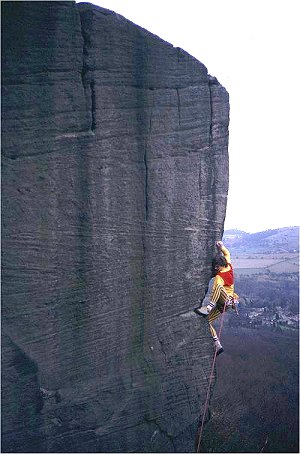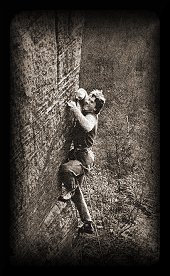E7 6c
Froggatt Edge
 |
 |
 Images from the photoshoot as printed in Climber. All © Ian Smith
0 Pulling on pebbles 1 In the groove 2 Falling off 3 Reaching the crack 4 Top arete I 5 Top arete II Click here (273Kb) for Peak Scene first ascent report , from Climber May 1982. | |||||||
|
Acknowledgements
A big thank you to Ian Smith for generously allowing the use of his photos here and for his writing. Thanks also to Phil Kelly for the photo that didn't make it into Extreme Rock. |
Ian Smith recounts how he took the pictures:
"It was around mid-February in 1982, a cold, misty, damp day and we had been climbing in the morning. Conditions were not that pleasant and we retreated to Stoney caf� for a hot drink and to get warm. There in the caf� we met Jonny Woodward who I knew, although we were not close friends. At the time Jonny was one of the leading gritstone climbers of the day and I had had a number of photos published in magazines and guidebooks. Jonny enthused about his latest new route on Froggatt which he had climbed a few days earlier and suggested we go up to the crag and get some photos. However, he explained that the route needed three belayers and so it depended on how my companions felt about giving up their afternoon, forunately they were willing.
"We headed up to the crag and realized that Beau Geste was a really major route, one of the last great problems of Froggatt. It was centred around a blank ar�te; it began on the right side, pulled around the ar�te and finished up the blank-looking wall to the left of the upper ar�te. Jonny explained the belaying system he had adopted to do the route, one rope through Friends in a horizontal break way off to the right, one rope way off to the left to stop a big swing round if he fell while doing the crux secquence on the left and the third rope to go through the hard-to-place single runner (RP3 I think) which is placed after the crux to protect the upper part of the route.
"Jonny had actually made the first ascent a few days earlier (the Wednesday possibly) and the plan was to for him to do the route as well as possible, given the poor conditions, to get a sequence of photos. It was clearly a climb at the absolute upper limit of what was possible at the time, particularly as he was wearing what nowadays would be regarded as very crude and non-sticky boots (this being well before the introduction of the Boreal Fir�). He explained that he had top-roped it a number of times and had not been able to do it so he had decided that what was required was the adrenaline of trying it on the lead and seven falls later he had succeeded.
"The photo session went really well and Jonny climbed the route a couple of times for different photography angles and, it being a Sunday and Froggatt being a popular crag, created quite a stir as most of the climbers in the near vicinity stoppped their own climbing and sat around to watch Jonny at work. The first time he topped out the crowd broke out into spontaneous applause, very unusual behaviour for the normally reserved British climbers.
"Jonny initially graded the route E7 7b, at a time when the British grading system was undergoing some changes, it seems that now it has settled to a consensus E6 6c. Unusually for a major route on a popular crag it took quite a long time, four years I think, to receive a second ascent.
"I�ve always regarded myself as lucky to have met Jonny that day, at that time first ascensionists on cutting edge routes did not always get photographed the way that they are now. The weather wasn�t too favourable to photography that day, flat, dull light but fortunately I was, at that time, shooting a lot of gritstone routes in black and white, much more tolerant of poor light and I still think the best medium for capturing the shapes and textures of climbers on gritstone."
 Mark Leach making the fourth ascent © Phil Kelly |
|
The Crux
Part of the reason why BG is such a special route lies in the distinct nature of the crux. Moving from the break to gain the thin vertical crack in the centre of the face is as complicated as it is delightful. Left foot in the break, a subtle toehook helps, then the single-finger tips layaway quickly followed up by a snatch for the pebble (harder for the tall). Pulling and rocking over to the left to gain as much height as possible before stretching up with the left hand to tickle the crack. If you've got it in the right place a smart standup and you can contemplate how you're possibly going to get that crucial wire in. Fail, and you topple backwards until the ropes pull and the rock looms in. |
 Woodward on the crux © Ian Smith |
The Pebble Sometime early 2000, an unknown climber broke the pebble used in the crux sequence. What is left is about half of the original size. The move is stightly harder but not enough to warrent a higher technical grade. Please, if you're going to lead or toprope this route, DO NOT STAND ON THE PEBBLE! While it is possible to climb without it if you're tall, it would be a very sad loss and a mark of direspect for the rock if it goes completely. |